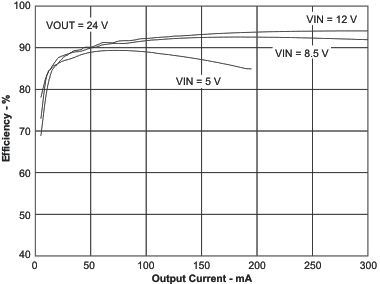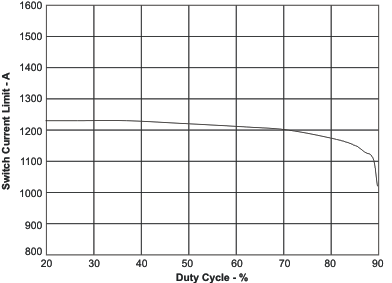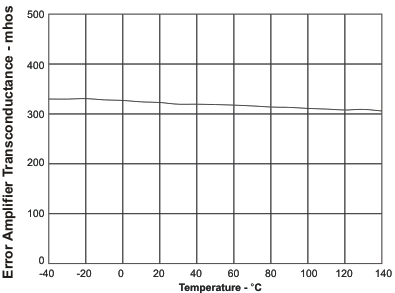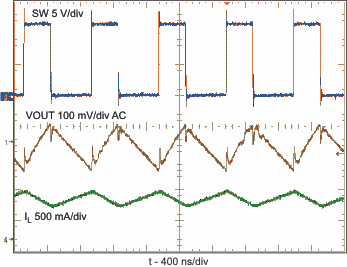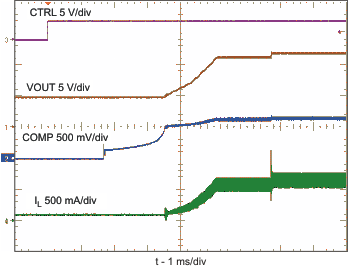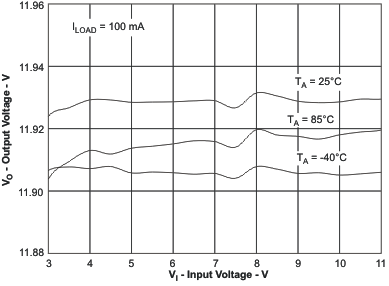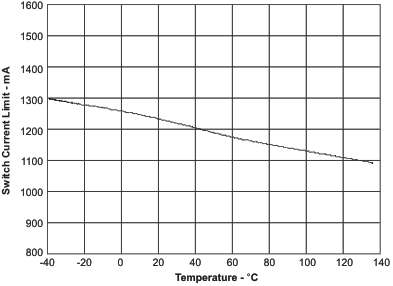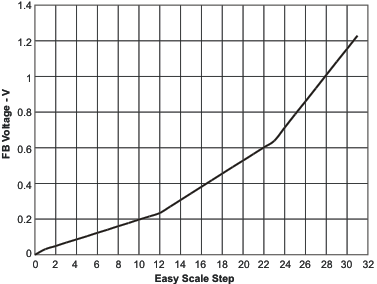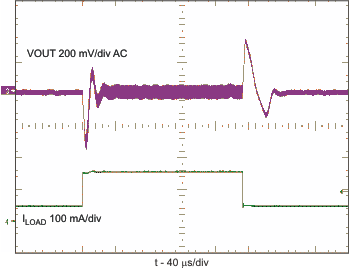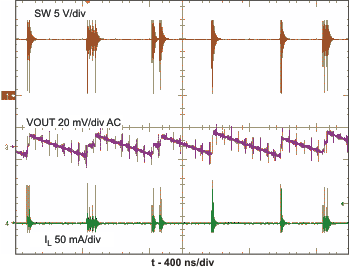ZHCS253A September 2011 – July 2015 TPS61170-Q1
PRODUCTION DATA.
- 1 特性
- 2 应用范围
- 3 说明
- 4 典型应用
- 5 修订历史记录
- 6 Pin Configuration and Functions
- 7 Specifications
- 8 Detailed Description
-
9 Application and Implementation
- 9.1 Application Information
- 9.2 Typical Applications
- 10Power Supply Recommendations
- 11Layout
- 12器件和文档支持
- 13机械、封装和可订购信息
7 Specifications
7.1 Absolute Maximum Ratings
over operating free-air temperature range (unless otherwise noted) (1)| MIN | MAX | UNIT | ||
|---|---|---|---|---|
| VI | Supply voltages on VIN (2) | –0.3 | 20 | V |
| Voltages on CTRL(2) | –0.3 | 20 | ||
| Voltage on FB and COMP(2) | –0.3 | 3 | ||
| Voltage on SW(2) | –0.3 | 40 | ||
| PD | Continuous power dissipation | See Thermal Information | ||
| TJ | Operating junction temperature | –40 | 150 | °C |
| Tstg | Storage temperature | –65 | 150 | °C |
(1) Stresses beyond those listed under Absolute Maximum Ratings may cause permanent damage to the device. These are stress ratings only, and functional operation of the device at these or any other conditions beyond those indicated under Recommended Operating Conditions is not implied. Exposure to absolute-maximum-rated conditions for extended periods may affect device reliability.
(2) All voltage values are with respect to network ground terminal.
7.2 ESD Ratings
| VALUE | UNIT | |||||
|---|---|---|---|---|---|---|
| V(ESD) | Electrostatic discharge | Human body model (HBM), per ANSI/ESDA/JEDEC JS-001, all pins(1) | ±2000 | V | ||
| Charged device model (CDM), per JEDEC specification JESD22-C101, all pins | Corner pins (FB, GND, VIN, and SW) | ±750 | ||||
| Other pins | ±500 | |||||
(1) AEC Q100-002 indicates that HBM stressing shall be in accordance with the ANSI/ESDA/JEDEC JS-001 specification.
7.3 Recommended Operating Conditions
| MIN | NOM | MAX | UNIT | ||
|---|---|---|---|---|---|
| VI | Input voltage range, VIN | 3 | 18 | V | |
| VO | Output voltage range | VIN | 38 | V | |
| L | Inductor(1) | 10 | 22 | μH | |
| CI | Input capacitor | 1 | μF | ||
| CO | Output capacitor(1) | 1 | 10 | μF | |
| TA | Operating ambient temperature | –40 | 125 | °C | |
| TJ | Operating junction temperature | –40 | 125 | °C |
(1) These values are recommended values that have been successfully tested in several applications. Other values may be acceptable in other applications but should be fully tested by the user.
7.4 Thermal Information
| THERMAL METRIC(1) | TPS61170-Q1 | UNIT | |
|---|---|---|---|
| DRV (SON) | |||
| 6 PINS | |||
| RθJA | Junction-to-ambient thermal resistance | 96.1 | °C/W |
| RθJC(top) | Junction-to-case (top) thermal resistance | 89 | °C/W |
| RθJB | Junction-to-board thermal resistance | 65.9 | °C/W |
| ψJT | Junction-to-top characterization parameter | 3.2 | °C/W |
| ψJB | Junction-to-board characterization parameter | 66.3 | °C/W |
| RθJC(bot) | Junction-to-case (bottom) thermal resistance | 40.8 | °C/W |
(1) For more information about traditional and new thermal metrics, see the Semiconductor and IC Package Thermal Metrics application report, SPRA953.
7.5 Electrical Characteristics
VIN = 3.6 V, CTRL = VIN, TA = –40°C to 125°C, typical values are at TA = 25°C (unless otherwise noted)| PARAMETER | TEST CONDITIONS | MIN | TYP | MAX | UNIT | |
|---|---|---|---|---|---|---|
| SUPPLY CURRENT | ||||||
| VI | Input voltage range, VIN | 3.0 | 18 | V | ||
| IQ | Operating quiescent current into VIN | Device PWM switching no load | 2.3 | mA | ||
| ISD | Shutdown current | CRTL = GND, VIN = 4.2 V | 1 | μA | ||
| UVLO | Undervoltage lockout threshold | VIN falling | 2.2 | 2.5 | V | |
| Vhys | Undervoltage lockout Hysteresis | 70 | mV | |||
| ENABLE AND REFERENCE CONTROL | ||||||
| V(CTRLh) | CTRL logic high voltage | VIN = 3 V to 18 V | 1.2 | V | ||
| V(CTRL) | CTRL logic low voltage | VIN = 3 V to 18 V | 0.4 | V | ||
| R(CTRL) | CTRL pulldown resistor | 400 | 800 | 1600 | kΩ | |
| VOLTAGE AND CURRENT CONTROL | ||||||
| VREF | Voltage feedback regulation voltage | 1.204 | 1.229 | 1.254 | V | |
| V(REF_PWM) | Voltage feedback regulation voltage under reprogram | VFB = 492 mV | 477 | 492 | 507 | mV |
| IFB | Voltage feedback input bias current | VFB = 1.229 V | 200 | nA | ||
| Dmax | Maximum duty cycle | VFB = 100 mV | 90% | 93% | ||
| Isink | Comp pin sink current | 100 | μA | |||
| Isource | Comp pin source current | 100 | μA | |||
| Gea | Error amplifier transconductance | 240 | 320 | 400 | μmho | |
| Rea | Error amplifier output resistance | 5 pF connected to COMP | 6 | MΩ | ||
| POWER SWITCH | ||||||
| RDS(on) | N-channel MOSFET ON-resistance | VIN = 3.6 V | 0.3 | 0.6 | Ω | |
| VIN = 3.0 V | 0.7 | |||||
| ILN_NFET | N-channel leakage current | VSW = 35 V, TA = 25°C | 1 | μA | ||
| OC AND SS | ||||||
| ILIM | N-channel MOSFET current limit | D = Dmax | 0.96 | 1.2 | 1.44 | A |
| ILIM_Start | Start-up current limit | D = Dmax | 0.7 | A | ||
| EasyScale TIMING | ||||||
| VACKNL | Acknowledge output voltage low | Open-drain, Rpullup =15 kΩ to Vin | 0.4 | V | ||
| THERMAL SHUTDOWN | ||||||
| Tshutdown | Thermal shutdown threshold | 160 | °C | |||
| Thysteresis | Thermal shutdown threshold hysteresis | 15 | °C | |||
(1) Acknowledge condition active 0, this condition will only be applied if the RFA bit is set. Open-drain output, line must be pulled high by the host with resistor load.
7.6 Switching Characteristics
VIN = 3.6 V, CTRL = VIN, TA = –40°C to 125°C, typical values are at TA = 25°C (unless otherwise noted)| PARAMETER | TEST CONDITIONS | MIN | TYP | MAX | UNIT | |
|---|---|---|---|---|---|---|
| ENABLE AND REFERENCE CONTROL | ||||||
| toff | EasyScale detection time(1) | CTRL high to low | 2.5 | ms | ||
| tes_det | EasyScale detection time(1) | CTRL pin low | 260 | μs | ||
| tes_delay | EasyScale detection delay | 100 | μs | |||
| tes_win | EasyScale detection window time | 1 | ms | |||
| VOLTAGE AND CURRENT CONTROL | ||||||
| fS | Oscillator frequency | 1 | 1.2 | 1.5 | MHz | |
| tmin_on | Minimum on pulse width | 40 | ns | |||
| fea | Error amplifier crossover frequency | 5 pF connected to COMP | 500 | kHz | ||
| OC AND SS | ||||||
| tHalf_LIM | Time step for half current limit | 5 | ms | |||
| tREF | Vref filter time constant | 180 | μs | |||
| tstep | VREF ramp-up time | 213 | μs | |||
| EasyScale TIMING | ||||||
| tstart | Start time of program stream | 2 | μs | |||
| tEOS | End time of program stream | 2 | 360 | μs | ||
| tH_LB | High time low bit | Logic 0 | 2 | 180 | μs | |
| tL_LB | Low time low bit | Logic 0 | 2 × tH_LB | 360 | μs | |
| tH_HB | High time high bit | Logic 1 | 2 × tL_HB | 360 | μs | |
| tL_HB | Low time high bit | Logic 1 | 2 | 180 | μs | |
| tvalACKN | Acknowledge valid time | See (1) | 2 | μs | ||
| tACKN | Duration of acknowledge condition | See (1) | 512 | μs | ||
(1) EasyScale communication is allowed immediately after the CTRL pin has been low for more than tes_det. To select EasyScale mode, the CTRL pin must be low for more than tes_det the end of tes_win.
7.7 Typical Characteristics
L = TOKO A915_Y-100M, D1 = ONsemi MBR0540T1, unless otherwise notedTable 1. Table of Graphs
| 典型应用 | FIGURE | ||
|---|---|---|---|
| Efficiency | VIN = 5V; VOUT = 12 V, 18 V, 24 V, 30 V | Figure 17 | |
| Efficiency | VIN = 5 V, 8.5 V, 12 V; VOUT = 24 V | Figure 1 | |
| Output voltage accuracy | ILOAD= 100 mA | Figure 2 | |
| Switch current limit | TA = 25°C | Figure 3 | |
| Switch current limit | Figure 4 | ||
| Error amplifier transconductance | Figure 5 | ||
| EasyScale step | Figure 6 | ||
| PWM switching operation | VIN = 5 V; VOUT = 12 V; ILOAD= 250 mA | Figure 7 | |
| Load transient response | VIN = 5 V; VOUT = 12 V; ILOAD= 50 mA to 150 mA | Figure 8 | |
| Start-up | VIN = 5 V; VOUT = 12 V; ILOAD= 250 mA | Figure 9 | |
| Skip-cycle switching | VIN = 9 V ; VOUT = 12 V, ILOAD= 100 μA | Figure 10 | |
